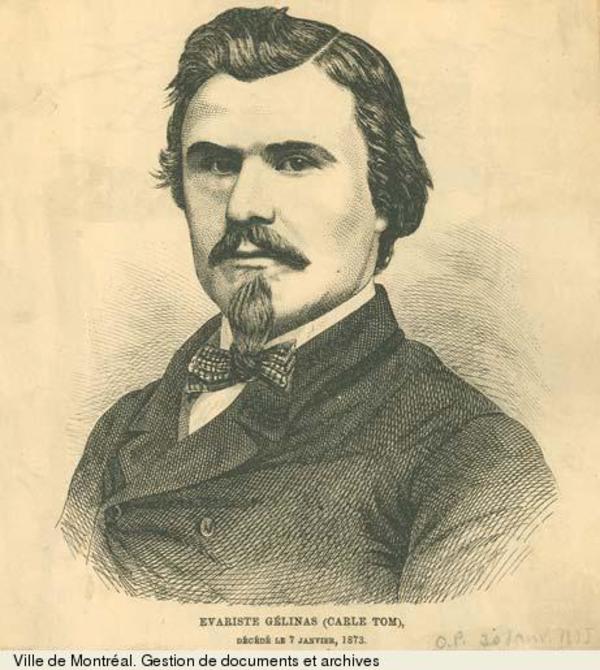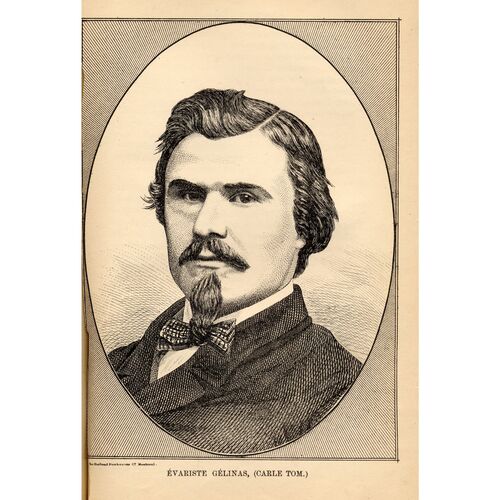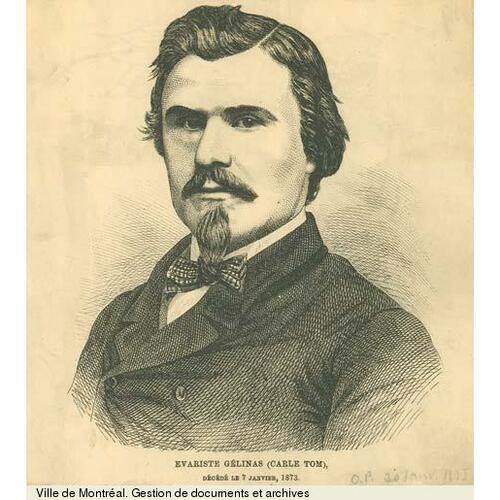
Source: Link
GÉLINAS, ÉVARISTE, journalist, federal civil servant; b. 1840 at Saint-Barnabé, Saint-Maurice County, not far from Yamachiche, L.C., of the second marriage of Joseph Gélinas, with Théotiste Hudon-Beaulieu; d. 7 Jan. 1873 at Ottawa, Ont.
According to Benjamin Sulte*, Évariste Gélinas’ family was descended from Étienne Gélineau (he signed Gellyneau or Gélineau), who was born at Saintes, the capital of Saintonge, and who had emigrated to Canada with his son Jean in 1662. His grandsons were among the first to make their home at Yamachiche, where they had numerous descendants with the names Gélinas, Gérin, Lacourse, and Bellemare.
In his 13th year, in October 1852, Évariste Gélinas entered the college and seminary of Nicolet to receive a classical education, which he completed in 1860. A philosophy student, he had been elected president of the college in 1859, the same year the establishment acquired a distinguished superior in Abbé Louis-François Laflèche*. Since his return from the Canadian west in July 1856 Laflèche had had unrivalled influence on the students, thanks to his lively eloquence and fluency as a teacher and his ascendancy as a priest who for 12 years of his life had been a missionary engaged in spreading the gospel.
Shortly after leaving the college, and following in the footsteps of Antoine Gérin-Lajoie* and Raphaël Bellemare, both inhabitants of Yamachiche and his relatives, Gélinas joined La Minerve, and was responsible for almost all the editorial work from 1861 to 1865. Being at the head of the principal Lower Canadian newspaper, a Conservative party organ, he had to manœuvre in difficult circumstances: not the least of these were three general elections, three changes of ministry, and particularly the alliance that George-Étienne Cartier, then at the height of his political power and enjoying the clergy’s support, made, to the stupefaction of his opponents, with George Brown, in order to prepare the way for confederation. The Liberal journals such as Le Défricheur, directed by Jean-Baptiste-Éric Dorion*, Le Pays under Charles Daoust* (in December 1863 he had succeeded Louis-Antoine Dessaulles* as editor), Médéric Lanctot’s L’Union rationale, and finally L’Ordre denounced this alliance, and sought to win the clergy’s trust. “It is our right,” the journalist of L’Ordre wrote on 4 July 1864, “to make a proud appeal to the sympathies of the clergy of the country. To wish to deny the enormous influence the clergy has exercised for some years in our country’s political affairs would be to lie to our conscience, and an act of the most cowardly hypocrisy. Without a doubt, this influence has been exerted on the side of the Conservative party only under the honest and patriotic impression that thereby the preservation of religion and consequently of nationality was being assured. Today all is unmasked!”
Évariste Gélinas replied in his best vein to this self-seeking invitation. In La Minerve of 9 July 1864 he gave an example of his style, and of the level of polemics at that time: “The Rouge press . . . finds itself suddenly smitten with a noble passion for what was previously the butt of its sarcasm. It becomes national, patriotic, nay, religiously minded. Behold, it is now the high principled press! Why, it even goes so far as to woo the clergy; it no longer fears either the stole or the holy water!” Attacking at the same time Dessaulles and the other liberal journalists who, logically to them, favoured Italian unification and consequently wished to see the disappearance of the Pope’s temporal power, which Catholics as a whole then considered essential for the country’s spiritual independence, Gélinas added vehemently: “You, the supporters of Catholicism, nonsense! But are you even Catholics? How long have you ceased to be free thinkers? And dear Garibaldi, you would abandon him outright! Thankless individuals!”
These four years of intense labour in the field of journalism had impaired his health. In 1865, for a rest, Gélinas went to Europe to travel. On his return some months later, he obtained from the Conservative party, which he had served loyally, the post of supernumerary first class in the Department of Militia at Ottawa. During the leisure that his occupation as a public servant left him, Évariste Gélinas returned to journalism, but as a freelance writer; he wrote witty articles for La Minerve and L’Opinion publique which he signed with the initials C. T. or the pseudonym Carle Tom or as “Un Solitaire.” These sparkling causeries raised him straightaway to the level of a Hector Fabre*, who on Gélinas’ death at the young age of 33 rendered homage in L’Événement of 10 Jan. 1873 to his rival’s talent as a humorist: “A collection of his chronicles would form a piquant volume to which one might give the title of Comédie humaine.”
On 3 Sept. 1862, at Quebec, Évariste Gélinas had married Mathilde, the second daughter of Étienne Parent; she bore him four sons.
ANQ, Collection Chapais, Fonds Langevin, É. Gélinas à H.-L. Langevin, 8 nov. 1864. St Joseph’s Church (Ottawa), Register of burials. Le Canadien (Québec), 10 janv. 1873. Le Constitutionnel (Trois-Rivières), 8 janv. 1873. Le Courrier de l’Outaouais (Hull), 8 janv. 1873. L’Événement (Québec), 10 janv. 1873. Le Journal des Trois-Rivières, 9 janv. 1873. L’Opinion publique (Montréal), 30 janv. 1873. L’Union des Cantons de l’Est (Arthabaska), 9 janv. 1873. Tanguay, Dictionnaire, IV. F.-L. Desaulniers, Les vieilles familles d’Yamachiche (4v., Montréal, 1898–1908), II, 197, 237. J.-A.-I. Douville, Histoire du collège-séminaire de Nicolet, 1803–1903, avec les listes complètes des directeurs, professeurs et élèves de l’institution (2v., Montréal, 1903), I, 323, 454; II, 180. Benjamin Sulte, “Nos écrivains d’il y a cinquante ans,” Le Bien public (Trois-Rivières), 5 Sept. 1918.
Cite This Article
Philippe Sylvain, “GÉLINAS, ÉVARISTE,” in Dictionary of Canadian Biography, vol. 10, University of Toronto/Université Laval, 2003–, accessed December 31, 2025, https://www.biographi.ca/en/bio/gelinas_evariste_10E.html.
The citation above shows the format for footnotes and endnotes according to the Chicago manual of style (16th edition). Information to be used in other citation formats:
| Permalink: | https://www.biographi.ca/en/bio/gelinas_evariste_10E.html |
| Author of Article: | Philippe Sylvain |
| Title of Article: | GÉLINAS, ÉVARISTE |
| Publication Name: | Dictionary of Canadian Biography, vol. 10 |
| Publisher: | University of Toronto/Université Laval |
| Year of publication: | 1972 |
| Year of revision: | 1972 |
| Access Date: | December 31, 2025 |




